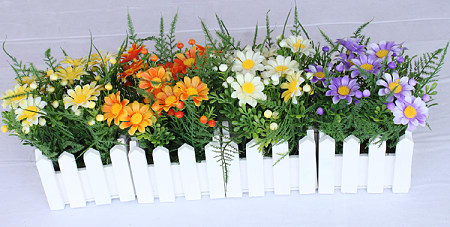Ten of the Chinese chrysanthemum flowers introduce articles
Published: 2014-10-20 Source: Fusheng Arts Clicks:
Daisy, alias called yellow, life off, Kim English, Huang Hua, Chrysanthemum, Tao Ju, Yi Ju. Asteraceae perennial herb, it was tongue or tubular petals. Height 20 ~ 200cm, usually 30 ~ 90cm. Stem color light green or brown, in addition to the cliff outside chrysanthemum mostly erect branching, semi-woody base. Leaves alternate, oval to oblong, notched and serrated edges. Capitulum or axillary, one or a few flowers in clusters. Ray florets for female, tubular flowers bisexual flowers. Ray florets into the next, spoon pipes, abnormal four rich colors, red, yellow, white, ink, purple, green, orange, pink, brown, lilac, light green and so on. Tubular flowers develop into a variety of colors & ldquo; care Gui flap & rdquo ;, colors are red, yellow, white, purple, green, pink, complex color, between color and other colors. Inflorescence size and shape are different, are ill, have petals; has flat, spherical; floc long, with short Xu, a flat floc floc and volume; hollow and solid; has straight and drooping, style many varieties complicated.
There are more than 30 species of the genus Chrysanthemum, 17 kinds of Chinese origin, are: Chrysanthemum, white chrysanthemums, Mao Huaju, chamomile, red daisy, purple chrysanthemum, chrysanthemum brain. Hi cool, relatively cold, growth temperature 18 ~ 21 ℃, underground rhizomes drought, very sensitive to waterlogging, like high altitude, deep soil, rich in humus, loose and fertile, well-drained loam. In slightly acidic to slightly alkaline soil Jieneng growth. And to Ph6.2 ~ 6.7 is best. For short-day plants, 14.5 hours in the day, long-day vegetative growth, more than 12 hours of darkness each day and night temperature 10 ℃ suitable for flower bud development.
Daisy is one of China's top ten flowers are cultivated through long-term artificial selection of rare ornamental flowers, varieties of three thousand species. In China there are three thousand years of cultural history, Chinese chrysanthemum introduced to Europe around the Ming and Qing. In Chinese classical literature and culture, plum, orchid, bamboo, chrysanthemum collectively known as the four gentlemen. Chinese people very loving chrysanthemum, daisy from folk had annual event from the Song Dynasty. Chinese poets painter, daisy theme of numerous poetry and painting, and thus a large number of ancient literature and art praise chrysanthemum daisy art experience, giving people the impression of many names spectral masterpiece, and spread long.
Daisy, in ancient myths and legends, Daisy was given a good luck, long life meaning. There are clean, noble, I love you, the truth, it is nostalgia, high moral character meaning.
Daisy has some food value, as early as the Warring States period, someone eating fresh chrysanthemums. Tang and Song dynasties, leaving the body of aromatic plants emit more records taking aroma. In some developed countries eat today has been very popular flower in our Beijing, Tianjin, Nanjing, Guangzhou, Wuhan and other places, is becoming fashionable.
In the "Shen Nong's Herbal Classic", the chrysanthemum as a top grade medicine for that & ldquo; Jiufu Lee blood, light-resistant old sickness & rdquo ;. But not all of chrysanthemums can eat. Edible chrysanthemum daisy called true, mainly in Guangdong.
Daisy is also a sign of the Japanese national emblem, and the chrysanthemum is one of Japan's national flower, you can see the extent of the daisy-known in the East Asian region.

There are more than 30 species of the genus Chrysanthemum, 17 kinds of Chinese origin, are: Chrysanthemum, white chrysanthemums, Mao Huaju, chamomile, red daisy, purple chrysanthemum, chrysanthemum brain. Hi cool, relatively cold, growth temperature 18 ~ 21 ℃, underground rhizomes drought, very sensitive to waterlogging, like high altitude, deep soil, rich in humus, loose and fertile, well-drained loam. In slightly acidic to slightly alkaline soil Jieneng growth. And to Ph6.2 ~ 6.7 is best. For short-day plants, 14.5 hours in the day, long-day vegetative growth, more than 12 hours of darkness each day and night temperature 10 ℃ suitable for flower bud development.
Daisy is one of China's top ten flowers are cultivated through long-term artificial selection of rare ornamental flowers, varieties of three thousand species. In China there are three thousand years of cultural history, Chinese chrysanthemum introduced to Europe around the Ming and Qing. In Chinese classical literature and culture, plum, orchid, bamboo, chrysanthemum collectively known as the four gentlemen. Chinese people very loving chrysanthemum, daisy from folk had annual event from the Song Dynasty. Chinese poets painter, daisy theme of numerous poetry and painting, and thus a large number of ancient literature and art praise chrysanthemum daisy art experience, giving people the impression of many names spectral masterpiece, and spread long.
Daisy, in ancient myths and legends, Daisy was given a good luck, long life meaning. There are clean, noble, I love you, the truth, it is nostalgia, high moral character meaning.
Daisy has some food value, as early as the Warring States period, someone eating fresh chrysanthemums. Tang and Song dynasties, leaving the body of aromatic plants emit more records taking aroma. In some developed countries eat today has been very popular flower in our Beijing, Tianjin, Nanjing, Guangzhou, Wuhan and other places, is becoming fashionable.
In the "Shen Nong's Herbal Classic", the chrysanthemum as a top grade medicine for that & ldquo; Jiufu Lee blood, light-resistant old sickness & rdquo ;. But not all of chrysanthemums can eat. Edible chrysanthemum daisy called true, mainly in Guangdong.
Daisy is also a sign of the Japanese national emblem, and the chrysanthemum is one of Japan's national flower, you can see the extent of the daisy-known in the East Asian region.

 English
English 中文版
中文版
 skype
skype Alibaba
Alibaba